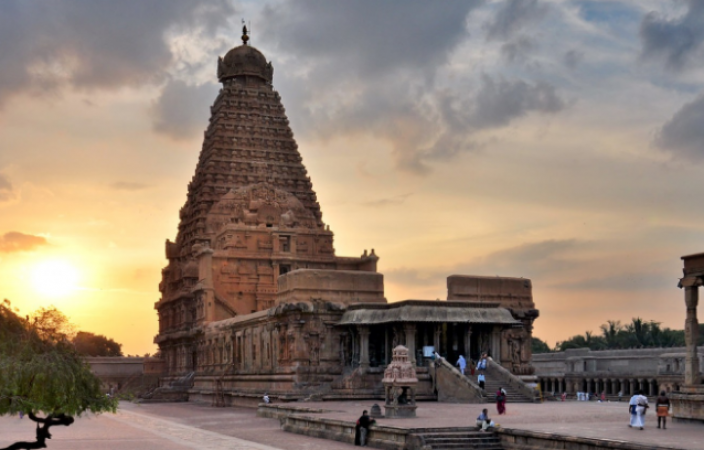
The Brihadeeswara Temple, also known as the Peruvudaiyar Kovil or Rajarajeswaram, is a magnificent Hindu temple dedicated to Lord Shiva. Located in the city of Thanjavur in Tamil Nadu, India, this architectural marvel stands as a testament to the artistic and engineering prowess of the Chola dynasty. Spanning over a thousand years, the temple's history is rich with cultural significance and religious devotion. In this article, we will delve into the captivating history of the Brihadeeswara Temple, exploring its architectural splendor and uncovering the rituals and practices associated with worshiping at this sacred site.
History of the Brihadeeswara Temple:
The Brihadeeswara Temple was built in the 11th century by the Chola king, Rajaraja I, to showcase his power and devotion to Lord Shiva. Construction of the temple commenced around 1002 CE and was completed in 1010 CE. The temple was designed by the renowned architect Kunjara Mallan Raja Raja Perunthachan, who conceptualized the magnificent structure and oversaw its construction.
The temple is an exemplary specimen of Dravidian architecture, characterized by its towering vimana (temple tower), expansive courtyards, intricate sculptures, and elaborate frescoes. The main vimana stands at a staggering height of 216 feet and is adorned with intricate carvings and sculptures depicting mythological narratives and religious symbolism. The temple complex also houses several smaller shrines, mandapas (pavilions), and gopurams (gateways), all contributing to its grandeur.
Worship at the Brihadeeswara Temple:
Worship at the Brihadeeswara Temple follows ancient Vedic rituals and traditions. Devotees from all over the world visit this sacred site to seek blessings, offer prayers, and experience the divine aura of Lord Shiva. Here is a step-by-step guide on how to worship at the Brihadeeswara Temple:
Dress Code and Entry: Visitors are required to dress modestly and adhere to the temple's dress code. Men are expected to wear traditional attire such as dhoti (a wrapped garment) or formal trousers, while women should wear sarees or modestly draped clothing. Upon entry, visitors must remove their footwear as a sign of respect.
Outer Prakaram: The temple complex is divided into multiple prakarams (circumambulatory paths). Begin your worship by circumambulating the outer prakaram in a clockwise direction. Take the time to appreciate the intricate sculptures and carvings that adorn the walls.
Inner Prakaram: Proceed to the inner prakaram, which leads to the main sanctum sanctorum. As you walk through this path, you will encounter various mandapas and shrines dedicated to different deities. Take a moment to offer prayers and seek blessings at each shrine.

Main Sanctum Sanctorum: The main shrine houses the grand idol of Lord Brihadeeswara (Shiva). Here, devotees offer flowers, fruits, and other traditional offerings to the deity. Priests perform elaborate rituals and offer prayers on behalf of the devotees. It is customary to maintain silence and observe utmost reverence during this time.
Arati and Prasadam: Witness the mesmerizing arati (ceremonial waving of lamps) performed by the priests. The rhythmic chants and the radiant glow of the lamps create a spiritually uplifting experience. After the arati, prasad (consecrated food) is distributed to the devotees as a divine blessing.
Circumambulation and Final Prayers: Conclude your worship by circumambulating the sanctum sanctorum three times in a clockwise direction. This act symbolizes devotion, humility, and surrender to the divine. Offer your final prayers and express gratitude for the spiritual experience.
The Brihadeeswara Temple stands as a living testament to the architectural brilliance and religious fervor of the Chola dynasty. With its awe-inspiring design, intricate carvings, and spiritual ambiance, the temple attracts thousands of devotees and history enthusiasts every year. By following the traditional rituals and practices, worshipers can immerse themselves in the divine energy that permeates this sacred site.
Visiting the Brihadeeswara Temple is not just an architectural exploration but also a spiritual journey. The serene atmosphere, ancient rituals, and breathtaking artistry combine to create an unforgettable experience for all who enter its hallowed premises. Whether you are an ardent devotee or a curious traveler, this temple is a must-visit destination that promises to leave a lasting impression on your mind and soul.
Know about the roots of the ancient religion of India
Gomateshwara Temple: Monolithic Statues
The Significance of Bells in Temples: Unveiling Their Musical Charm